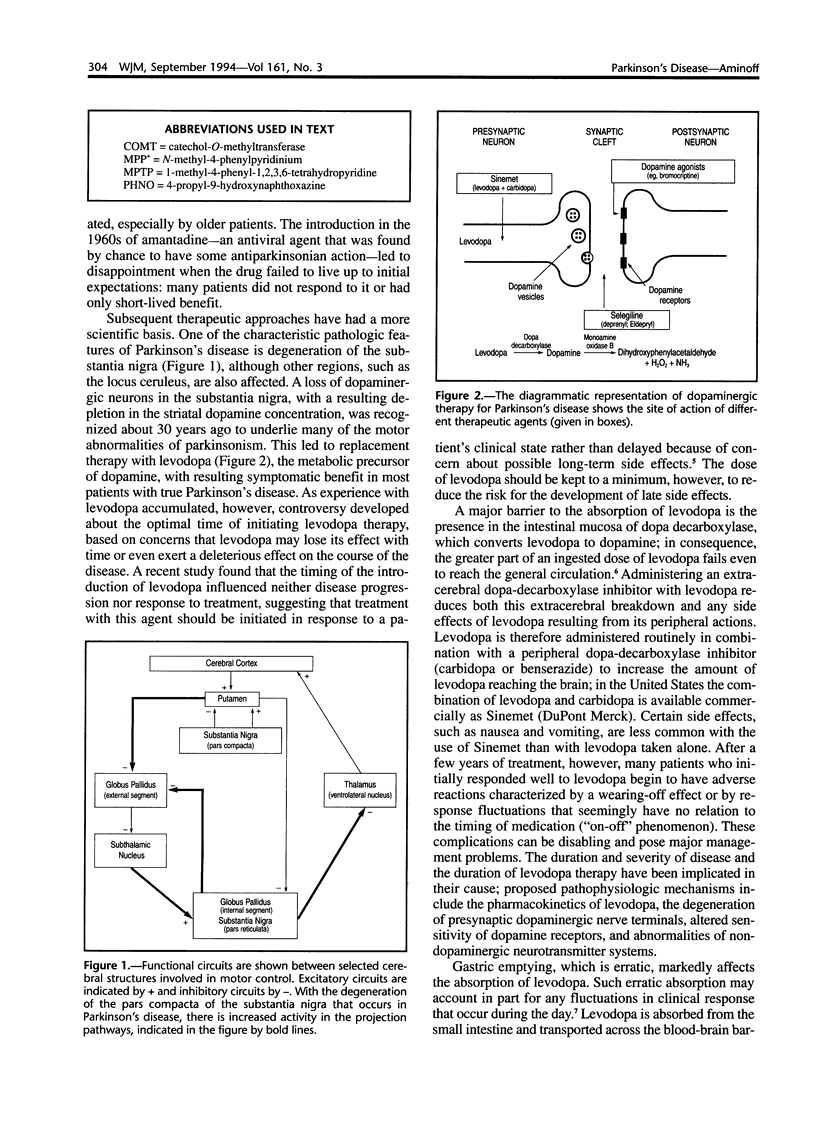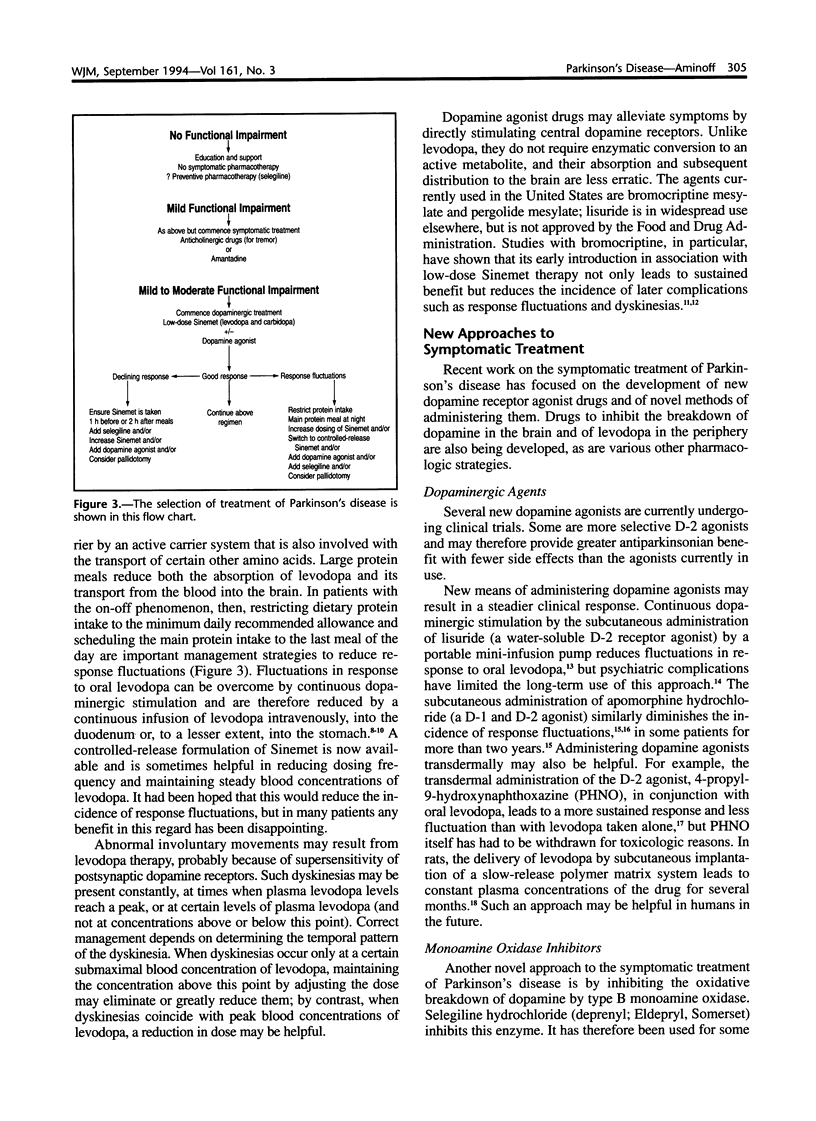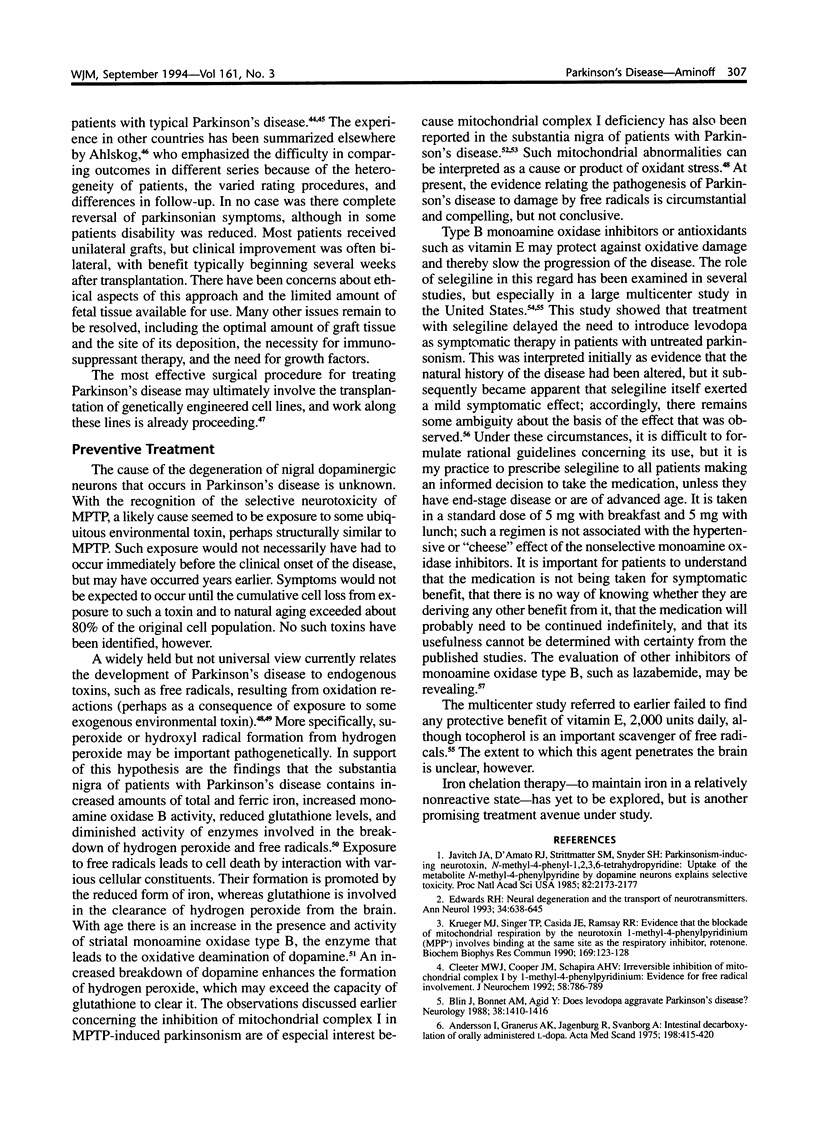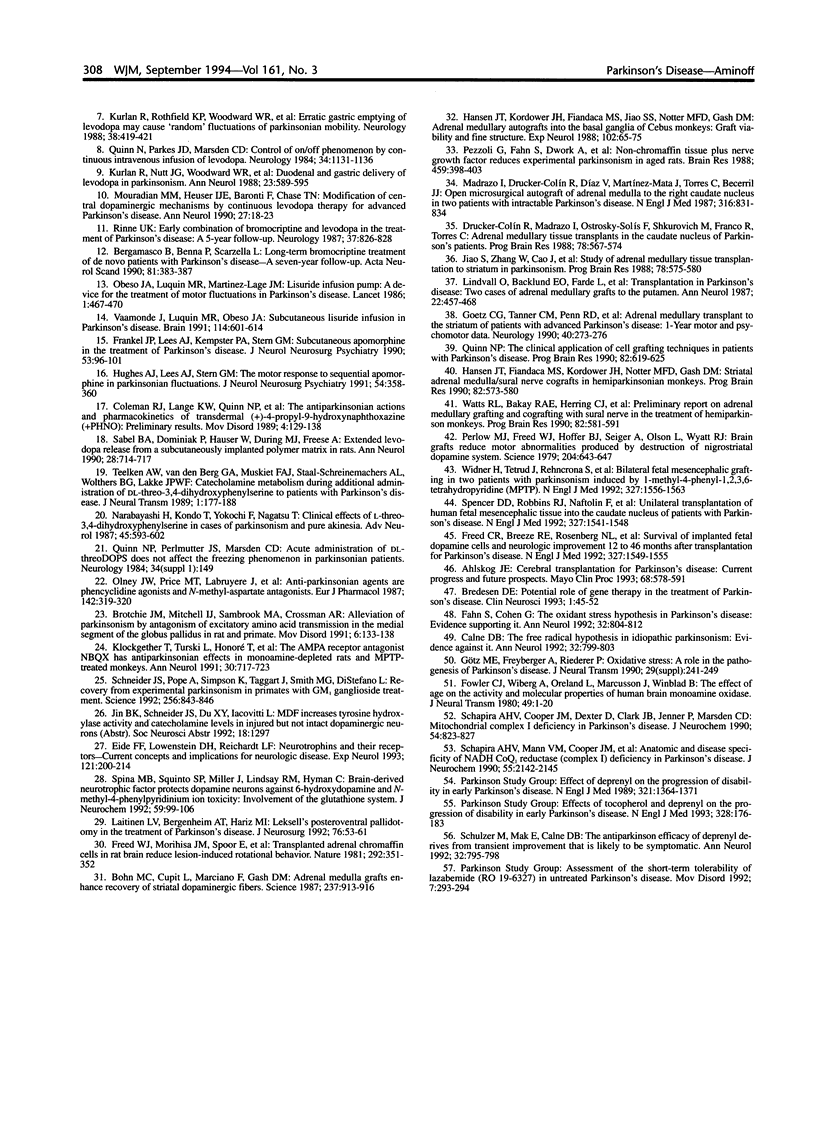Abstract
Pharmacotherapy with levodopa for Parkinson's disease provides symptomatic benefit, but fluctuations in (or loss of) response may eventually occur. Dopamine agonists are also helpful and, when taken with low doses of levodopa, often provide sustained benefit with fewer side effects; novel agonists and new methods for their administration are therefore under study. Other therapeutic strategies are being explored, including the use of type B monoamine oxidase inhibitors to reduce the metabolic breakdown of dopamine, catechol-O-methyltransferase inhibitors to retard the breakdown of levodopa, norepinephrine precursors to compensate for deficiency of this neurotransmitter, glutamate antagonists to counteract the effects of the subthalamic nucleus, and various neurotrophic factors to influence dopaminergic nigrostriatal cells. Surgical procedures involving pallidotomy are sometimes helpful. Those involving cerebral transplantation of adrenal medullary or fetal mesencephalic tissue have yielded mixed results; benefits may relate to the presence of growth factors in the transplanted tissue. The transplantation of genetically engineered cell lines will probably become the optimal transplantation procedure. The cause of Parkinson's disease may relate to oxidant stress and the generation of free radicals. It is not clear whether treatment with selegiline hydrochloride (a type B monoamine oxidase inhibitor) delays the progression of Parkinson's disease, because the drug also exerts a mild symptomatic effect. Daily treatment with vitamin E (a scavenger of free radicals) does not influence disease progression, perhaps because of limited penetration into the brain.
Full text
PDF





Images in this article
Selected References
These references are in PubMed. This may not be the complete list of references from this article.
- Ahlskog J. E. Cerebral transplantation for Parkinson's disease: current progress and future prospects. Mayo Clin Proc. 1993 Jun;68(6):578–591. doi: 10.1016/s0025-6196(12)60373-5. [DOI] [PubMed] [Google Scholar]
- Andersson I., Granerus A. K., Jagenburg R., Svanborg A. Intestinal decarboxylation of orally administered L-dopa. Influence of pharmacological preparations, dose magnitude, dose sequence and food intake. Acta Med Scand. 1975 Nov;198(5):415–420. [PubMed] [Google Scholar]
- Bergamasco B., Benna P., Scarzella L. Long-term bromocriptine treatment of de novo patients with Parkinson's disease. A seven-year follow-up. Acta Neurol Scand. 1990 May;81(5):383–387. doi: 10.1111/j.1600-0404.1990.tb00980.x. [DOI] [PubMed] [Google Scholar]
- Blin J., Bonnet A. M., Agid Y. Does levodopa aggravate Parkinson's disease? Neurology. 1988 Sep;38(9):1410–1416. doi: 10.1212/wnl.38.9.1410. [DOI] [PubMed] [Google Scholar]
- Bohn M. C., Cupit L., Marciano F., Gash D. M. Adrenal medulla grafts enhance recovery of striatal dopaminergic fibers. Science. 1987 Aug 21;237(4817):913–916. doi: 10.1126/science.2887034. [DOI] [PubMed] [Google Scholar]
- Brotchie J. M., Mitchell I. J., Sambrook M. A., Crossman A. R. Alleviation of parkinsonism by antagonism of excitatory amino acid transmission in the medial segment of the globus pallidus in rat and primate. Mov Disord. 1991;6(2):133–138. doi: 10.1002/mds.870060208. [DOI] [PubMed] [Google Scholar]
- Calne D. B. The free radical hypothesis in idiopathic parkinsonism: evidence against it. Ann Neurol. 1992 Dec;32(6):799–803. doi: 10.1002/ana.410320615. [DOI] [PubMed] [Google Scholar]
- Cleeter M. W., Cooper J. M., Schapira A. H. Irreversible inhibition of mitochondrial complex I by 1-methyl-4-phenylpyridinium: evidence for free radical involvement. J Neurochem. 1992 Feb;58(2):786–789. doi: 10.1111/j.1471-4159.1992.tb09789.x. [DOI] [PubMed] [Google Scholar]
- Coleman R. J., Lange K. W., Quinn N. P., Loper A. E., Bondi J. V., Hichens M., Stahl S. M., Marsden C. D. The antiparkinsonian actions and pharmacokinetics of transdermal (+)-4-propyl-9-hydroxynaphthoxazine (+PHNO): preliminary results. Mov Disord. 1989;4(2):129–138. doi: 10.1002/mds.870040204. [DOI] [PubMed] [Google Scholar]
- Drucker-Colín R., Madrazo I., Ostrosky-Solís F., Shkurovich M., Franco R., Torres C. Adrenal medullary tissue transplants in the caudate nucleus of Parkinson's patients. Prog Brain Res. 1988;78:567–574. doi: 10.1016/s0079-6123(08)60332-5. [DOI] [PubMed] [Google Scholar]
- Edwards R. H. Neural degeneration and the transport of neurotransmitters. Ann Neurol. 1993 Nov;34(5):638–645. doi: 10.1002/ana.410340504. [DOI] [PubMed] [Google Scholar]
- Eide F. F., Lowenstein D. H., Reichardt L. F. Neurotrophins and their receptors--current concepts and implications for neurologic disease. Exp Neurol. 1993 Jun;121(2):200–214. doi: 10.1006/exnr.1993.1087. [DOI] [PubMed] [Google Scholar]
- Fahn S., Cohen G. The oxidant stress hypothesis in Parkinson's disease: evidence supporting it. Ann Neurol. 1992 Dec;32(6):804–812. doi: 10.1002/ana.410320616. [DOI] [PubMed] [Google Scholar]
- Fowler C. J., Wiberg A., Oreland L., Marcusson J., Winblad B. The effect of age on the activity and molecular properties of human brain monoamine oxidase. J Neural Transm. 1980;49(1-2):1–20. doi: 10.1007/BF01249185. [DOI] [PubMed] [Google Scholar]
- Frankel J. P., Lees A. J., Kempster P. A., Stern G. M. Subcutaneous apomorphine in the treatment of Parkinson's disease. J Neurol Neurosurg Psychiatry. 1990 Feb;53(2):96–101. doi: 10.1136/jnnp.53.2.96. [DOI] [PMC free article] [PubMed] [Google Scholar]
- Freed C. R., Breeze R. E., Rosenberg N. L., Schneck S. A., Kriek E., Qi J. X., Lone T., Zhang Y. B., Snyder J. A., Wells T. H. Survival of implanted fetal dopamine cells and neurologic improvement 12 to 46 months after transplantation for Parkinson's disease. N Engl J Med. 1992 Nov 26;327(22):1549–1555. doi: 10.1056/NEJM199211263272202. [DOI] [PubMed] [Google Scholar]
- Freed W. J., Morihisa J. M., Spoor E., Hoffer B. J., Olson L., Seiger A., Wyatt R. J. Transplanted adrenal chromaffin cells in rat brain reduce lesion-induced rotational behaviour. Nature. 1981 Jul 23;292(5821):351–352. doi: 10.1038/292351a0. [DOI] [PubMed] [Google Scholar]
- Goetz C. G., Tanner C. M., Penn R. D., Stebbins G. T., 3rd, Gilley D. W., Shannon K. M., Klawans H. L., Comella C. L., Wilson R. S., Witt T. Adrenal medullary transplant to the striatum of patients with advanced Parkinson's disease: 1-year motor and psychomotor data. Neurology. 1990 Feb;40(2):273–276. doi: 10.1212/wnl.40.2.273. [DOI] [PubMed] [Google Scholar]
- Götz M. E., Freyberger A., Riederer P. Oxidative stress: a role in the pathogenesis of Parkinson's disease. J Neural Transm Suppl. 1990;29:241–249. doi: 10.1007/978-3-7091-9050-0_23. [DOI] [PubMed] [Google Scholar]
- Hansen J. T., Fiandaca M. S., Kordower J. H., Notter M. F., Gash D. M. Striatal adrenal medulla/sural nerve cografts in hemiparkinsonian monkeys. Prog Brain Res. 1990;82:573–580. doi: 10.1016/s0079-6123(08)62647-3. [DOI] [PubMed] [Google Scholar]
- Hansen J. T., Kordower J. H., Fiandaca M. S., Jiao S. S., Notter M. F., Gash D. M. Adrenal medullary autografts into the basal ganglia of Cebus monkeys: graft viability and fine structure. Exp Neurol. 1988 Oct;102(1):65–75. doi: 10.1016/0014-4886(88)90079-9. [DOI] [PubMed] [Google Scholar]
- Hughes A. J., Lees A. J., Stern G. M. The motor response to sequential apomorphine in parkinsonian fluctuations. J Neurol Neurosurg Psychiatry. 1991 Apr;54(4):358–360. doi: 10.1136/jnnp.54.4.358. [DOI] [PMC free article] [PubMed] [Google Scholar]
- Javitch J. A., D'Amato R. J., Strittmatter S. M., Snyder S. H. Parkinsonism-inducing neurotoxin, N-methyl-4-phenyl-1,2,3,6 -tetrahydropyridine: uptake of the metabolite N-methyl-4-phenylpyridine by dopamine neurons explains selective toxicity. Proc Natl Acad Sci U S A. 1985 Apr;82(7):2173–2177. doi: 10.1073/pnas.82.7.2173. [DOI] [PMC free article] [PubMed] [Google Scholar]
- Jiao S. S., Zhang W. C., Cao J. K., Zhang Z. M., Wang H., Ding M. C., Zhang Z., Sun J. B., Sun Y. C., Shi M. T. Study of adrenal medullary tissue transplantation to striatum in parkinsonism. Prog Brain Res. 1988;78:575–580. doi: 10.1016/s0079-6123(08)60333-7. [DOI] [PubMed] [Google Scholar]
- Klockgether T., Turski L., Honoré T., Zhang Z. M., Gash D. M., Kurlan R., Greenamyre J. T. The AMPA receptor antagonist NBQX has antiparkinsonian effects in monoamine-depleted rats and MPTP-treated monkeys. Ann Neurol. 1991 Nov;30(5):717–723. doi: 10.1002/ana.410300513. [DOI] [PubMed] [Google Scholar]
- Krueger M. J., Singer T. P., Casida J. E., Ramsay R. R. Evidence that the blockade of mitochondrial respiration by the neurotoxin 1-methyl-4-phenylpyridinium (MPP+) involves binding at the same site as the respiratory inhibitor, rotenone. Biochem Biophys Res Commun. 1990 May 31;169(1):123–128. doi: 10.1016/0006-291x(90)91442-u. [DOI] [PubMed] [Google Scholar]
- Kurlan R., Nutt J. G., Woodward W. R., Rothfield K., Lichter D., Miller C., Carter J. H., Shoulson I. Duodenal and gastric delivery of levodopa in parkinsonism. Ann Neurol. 1988 Jun;23(6):589–595. doi: 10.1002/ana.410230611. [DOI] [PubMed] [Google Scholar]
- Kurlan R., Rothfield K. P., Woodward W. R., Nutt J. G., Miller C., Lichter D., Shoulson I. Erratic gastric emptying of levodopa may cause "random" fluctuations of parkinsonian mobility. Neurology. 1988 Mar;38(3):419–421. doi: 10.1212/wnl.38.3.419. [DOI] [PubMed] [Google Scholar]
- Laitinen L. V., Bergenheim A. T., Hariz M. I. Leksell's posteroventral pallidotomy in the treatment of Parkinson's disease. J Neurosurg. 1992 Jan;76(1):53–61. doi: 10.3171/jns.1992.76.1.0053. [DOI] [PubMed] [Google Scholar]
- Lindvall O., Backlund E. O., Farde L., Sedvall G., Freedman R., Hoffer B., Nobin A., Seiger A., Olson L. Transplantation in Parkinson's disease: two cases of adrenal medullary grafts to the putamen. Ann Neurol. 1987 Oct;22(4):457–468. doi: 10.1002/ana.410220403. [DOI] [PubMed] [Google Scholar]
- Madrazo I., Drucker-Colín R., Díaz V., Martínez-Mata J., Torres C., Becerril J. J. Open microsurgical autograft of adrenal medulla to the right caudate nucleus in two patients with intractable Parkinson's disease. N Engl J Med. 1987 Apr 2;316(14):831–834. doi: 10.1056/NEJM198704023161402. [DOI] [PubMed] [Google Scholar]
- Mouradian M. M., Heuser I. J., Baronti F., Chase T. N. Modification of central dopaminergic mechanisms by continuous levodopa therapy for advanced Parkinson's disease. Ann Neurol. 1990 Jan;27(1):18–23. doi: 10.1002/ana.410270105. [DOI] [PubMed] [Google Scholar]
- Narabayashi H., Kondo T., Yokochi F., Nagatsu T. Clinical effects of L-threo-3,4-dihydroxyphenylserine in cases of parkinsonism and pure akinesia. Adv Neurol. 1987;45:593–602. [PubMed] [Google Scholar]
- Obeso J. A., Luquin M. R., Martínez-Lage J. M. Lisuride infusion pump: a device for the treatment of motor fluctuations in Parkinson's disease. Lancet. 1986 Mar 1;1(8479):467–470. doi: 10.1016/s0140-6736(86)92929-6. [DOI] [PubMed] [Google Scholar]
- Olney J. W., Price M. T., Labruyere J., Salles K. S., Frierdich G., Mueller M., Silverman E. Anti-parkinsonian agents are phencyclidine agonists and N-methyl-aspartate antagonists. Eur J Pharmacol. 1987 Oct 13;142(2):319–320. doi: 10.1016/0014-2999(87)90123-3. [DOI] [PubMed] [Google Scholar]
- Perlow M. J., Freed W. J., Hoffer B. J., Seiger A., Olson L., Wyatt R. J. Brain grafts reduce motor abnormalities produced by destruction of nigrostriatal dopamine system. Science. 1979 May 11;204(4393):643–647. doi: 10.1126/science.571147. [DOI] [PubMed] [Google Scholar]
- Pezzoli G., Fahn S., Dwork A., Truong D. D., de Yebenes J. G., Jackson-Lewis V., Herbert J., Cadet J. L. Non-chromaffin tissue plus nerve growth factor reduces experimental parkinsonism in aged rats. Brain Res. 1988 Sep 6;459(2):398–403. doi: 10.1016/0006-8993(88)90659-2. [DOI] [PubMed] [Google Scholar]
- Quinn N. P. The clinical application of cell grafting techniques in patients with Parkinson's disease. Prog Brain Res. 1990;82:619–625. doi: 10.1016/s0079-6123(08)62652-7. [DOI] [PubMed] [Google Scholar]
- Quinn N., Parkes J. D., Marsden C. D. Control of on/off phenomenon by continuous intravenous infusion of levodopa. Neurology. 1984 Sep;34(9):1131–1136. doi: 10.1212/wnl.34.9.1131. [DOI] [PubMed] [Google Scholar]
- Rinne U. K. Early combination of bromocriptine and levodopa in the treatment of Parkinson's disease: a 5-year follow-up. Neurology. 1987 May;37(5):826–828. doi: 10.1212/wnl.37.5.826. [DOI] [PubMed] [Google Scholar]
- Sabel B. A., Dominiak P., Hüaser W., During M. J., Freese A. Extended levodopa release from a subcutaneously implanted polymer matrix in rats. Ann Neurol. 1990 Nov;28(5):714–717. doi: 10.1002/ana.410280519. [DOI] [PubMed] [Google Scholar]
- Schapira A. H., Cooper J. M., Dexter D., Clark J. B., Jenner P., Marsden C. D. Mitochondrial complex I deficiency in Parkinson's disease. J Neurochem. 1990 Mar;54(3):823–827. doi: 10.1111/j.1471-4159.1990.tb02325.x. [DOI] [PubMed] [Google Scholar]
- Schapira A. H., Mann V. M., Cooper J. M., Dexter D., Daniel S. E., Jenner P., Clark J. B., Marsden C. D. Anatomic and disease specificity of NADH CoQ1 reductase (complex I) deficiency in Parkinson's disease. J Neurochem. 1990 Dec;55(6):2142–2145. doi: 10.1111/j.1471-4159.1990.tb05809.x. [DOI] [PubMed] [Google Scholar]
- Schneider J. S., Pope A., Simpson K., Taggart J., Smith M. G., DiStefano L. Recovery from experimental parkinsonism in primates with GM1 ganglioside treatment. Science. 1992 May 8;256(5058):843–846. doi: 10.1126/science.1350379. [DOI] [PubMed] [Google Scholar]
- Schulzer M., Mak E., Calne D. B. The antiparkinson efficacy of deprenyl derives from transient improvement that is likely to be symptomatic. Ann Neurol. 1992 Dec;32(6):795–798. doi: 10.1002/ana.410320614. [DOI] [PubMed] [Google Scholar]
- Spencer D. D., Robbins R. J., Naftolin F., Marek K. L., Vollmer T., Leranth C., Roth R. H., Price L. H., Gjedde A., Bunney B. S. Unilateral transplantation of human fetal mesencephalic tissue into the caudate nucleus of patients with Parkinson's disease. N Engl J Med. 1992 Nov 26;327(22):1541–1548. doi: 10.1056/NEJM199211263272201. [DOI] [PubMed] [Google Scholar]
- Spina M. B., Squinto S. P., Miller J., Lindsay R. M., Hyman C. Brain-derived neurotrophic factor protects dopamine neurons against 6-hydroxydopamine and N-methyl-4-phenylpyridinium ion toxicity: involvement of the glutathione system. J Neurochem. 1992 Jul;59(1):99–106. doi: 10.1111/j.1471-4159.1992.tb08880.x. [DOI] [PubMed] [Google Scholar]
- Teelken A. W., van den Berg G. A., Muskiet F. A., Staal-Schreinemachers A. L., Wolthers B. G., Lakke J. P. Catecholamine metabolism during additional administration of DL-threo-3,4-dihydroxyphenylserine to patients with Parkinson's disease. J Neural Transm Park Dis Dement Sect. 1989;1(3):177–188. doi: 10.1007/BF02248667. [DOI] [PubMed] [Google Scholar]
- Vaamonde J., Luquin M. R., Obeso J. A. Subcutaneous lisuride infusion in Parkinson's disease. Response to chronic administration in 34 patients. Brain. 1991 Feb;114(Pt 1B):601–617. doi: 10.1093/brain/114.1.601. [DOI] [PubMed] [Google Scholar]
- Watts R. L., Bakay R. A., Herring C. J., Sweeney K. M., Colbassani H. J., Mandir A., Byrd L. D., Iuvone P. M. Preliminary report on adrenal medullary grafting and cografting with sural nerve in the treatment of hemiparkinson monkeys. Prog Brain Res. 1990;82:581–591. doi: 10.1016/s0079-6123(08)62648-5. [DOI] [PubMed] [Google Scholar]
- Widner H., Tetrud J., Rehncrona S., Snow B., Brundin P., Gustavii B., Björklund A., Lindvall O., Langston J. W. Bilateral fetal mesencephalic grafting in two patients with parkinsonism induced by 1-methyl-4-phenyl-1,2,3,6-tetrahydropyridine (MPTP) N Engl J Med. 1992 Nov 26;327(22):1556–1563. doi: 10.1056/NEJM199211263272203. [DOI] [PubMed] [Google Scholar]



